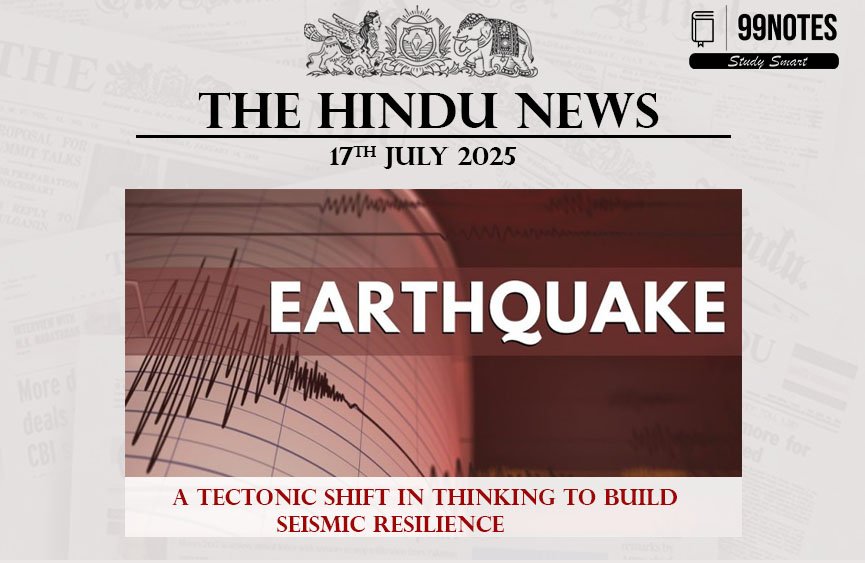17 July 2025: The Hindu Editorial
1. Some Cheer
Source – 10, The Hindu UPSC IAS Edition
| Topic: GS3 – Economy (External Sector, Trade Policy), GS2 – International Relations (Trade Negotiations) |
| Context |
|
Key Trade Trends in Q1 FY26
-
India’s merchandise exports for June 2025 stood at $35.14 billion, nearly unchanged from last year due to softer crude prices.
-
Services exports surged 11% YoY to $98.13 billion, aiding a 9.4% reduction in overall trade deficit to $67.26 billion.
-
The positive trend mirrors India’s long-term trajectory where services consistently outperform goods exports.
Drivers of Current Trade Dynamics
-
Surge in U.S.-bound shipments: June saw the sharpest rise in 14 months (23.5% growth to $8.3 billion) as importers stocked up before the “reciprocal tariff pause” extended to August 1.
-
Goods Export Performance: While petroleum, gems, and jewellery exports remained flat, sectors like electronics (46.93%), tea (32.64%), and marine products (13.33%) recorded strong growth.
-
However, petroleum products still dominate goods exports (15%), leaving India vulnerable to energy-linked external shocks.
Geopolitical Risk and Energy Security Concerns
-
India recently overtook China as the largest importer of Russian crude (36% of imports), leveraging cost arbitrage amid Western sanctions.
-
Risk factor: U.S. President Trump’s threat of 100% secondary tariffs on nations importing Russian oil could severely hit India’s trade.
-
Such dependence on discounted Russian oil poses strategic vulnerabilities in light of future sanctions or global energy realignments.
Strategic Need for Diversification
-
India must urgently diversify energy imports to mitigate geopolitical risks and price volatility.
-
Policy focus areas:
-
Expanding renewable energy adoption and electrification of transport.
-
Securing long-term LNG and crude deals with Middle East, Africa, and Latin America.
-
Boosting domestic exploration and refining capacities.
-
-
Further leveraging MSME-based exports, which form 46% of goods exports, can strengthen India’s trade base.
Implications for Trade Policy and Diplomacy
-
U.S. accounts for nearly 18% of India’s exports, making the upcoming bilateral trade negotiations critical for safeguarding market access.
-
Any escalation in tariff disputes could disrupt India’s export-driven growth, necessitating contingency frameworks and deeper engagement in multilateral trade forums (WTO).
Conclusion and Way Forward
India’s trade resilience depends on energy diversification, robust renewable capacity, and expansion of non-oil exports. The government must strategically balance geopolitical alignments with trade security while strengthening domestic R&D in energy and industrial competitiveness. Achieving this requires a multi-pronged strategy combining diplomacy, technology, and structural reforms.
|
Practice Question: “India’s rising dependence on Russian crude amidst global tariff uncertainty underscores the urgent need for energy diversification.” Analyze this statement in the context of India’s trade deficit management and energy security strategy. |
2. A Tectonic Shift in Thinking to Build Seismic Resilience
Source – Page 10, The Hindu UPSC IAS Edition
| Topic: GS1 – Geophysical Phenomena (Earthquakes and Disaster Risks) GS3 – Disaster Management, Infrastructure Resilience |
| Context |
|
Why India is Highly Vulnerable
-
Geological Context: India’s seismic risk arises from the northward drift of the Indian Plate colliding with the Eurasian Plate at a rate of 5 cm/year, forming the Himalayas. Scientists warn of a looming “Great Himalayan Earthquake” of magnitude 8 or higher, potentially impacting over 300 million people across northern India, Nepal, and Bhutan.
-
Seismic Zones: Delhi lies in Seismic Zone IV (high risk) with a peak ground acceleration (PGA) factor of 0.24g, making the city extremely vulnerable.
-
Urban Risks: Delhi’s rapid urbanization, unplanned development, and aging infrastructure—especially 33.5 million residents and over 5,000 high-rises—increase vulnerability.
Lessons from Recent Events
-
The July 2025 tremors, though moderate, exposed severe weaknesses in compliance with Bureau of Indian Standards (IS 1893:2016).
-
Past disasters like Bhuj earthquake (2001, magnitude 7.7) and Nepal earthquake (2015, magnitude 7.8) highlight the catastrophic potential of non-compliance.
Global and Regional Seismic Activity
-
Recent quakes in Myanmar (7.7 in March 2025) and Tibet (5.7 in May 2025) indicate heightened tectonic activity in Asia. Even distant events like the Greece quake (6.2 in May 2025) underscore global patterns of seismic unrest.
-
The Himalayan belt remains a ticking seismic clock, with repeated reminders since the 1905 Kangra quake and 2015 Nepal quake.
Urbanization and Risk Amplification
-
Uncontrolled urbanization in Delhi, especially in liquefaction-prone areas and poorly constructed high-rises, intensifies risks.
-
Monitoring gaps: While the IndiaQuake app offers early warnings, enforcement and compliance remain inadequate.
Best Practices and Global Lessons
-
Bangkok’s experience: Post-2007, Bangkok enforced high-strength concrete (30MPa-40MPa) and ductile detailing codes, reducing quake damage despite challenging soil conditions.
-
India must adopt similar strict IS code compliance, base isolation for critical infrastructure, and soil-strengthening measures in vulnerable zones.
What Needs to Be Done
-
Legal and Regulatory Enforcement: Implement and strictly enforce IS 1893:2016 norms.
-
Retrofitting and Investment: Allocate ₹50,000 crore for retrofitting vulnerable buildings and strengthening foundations.
-
Community Preparedness: Expand disaster response teams, public drills, and evacuation plans.
-
Technology Integration: Use real-time monitoring and AI-based predictive tools for rapid alerts.
Conclusion and Way Forward
With seismic activity intensifying globally and regionally, India cannot afford complacency. Building resilience is not just a technical challenge but a national priority and moral obligation to protect lives. There is an urgent need for a national dialogue on earthquake safety, strict enforcement of building codes, and investment in resilient infrastructure to prevent a catastrophic disaster in Delhi and beyond.
|
Practice Question: “ India’s growing urbanization in high-risk seismic zones demands urgent reforms in building codes and disaster preparedness.” Critically examine in the context of recent tremors in Delhi and global best practices. |
Read more about –16 July 2025: The Hindu Editorial Analysis



